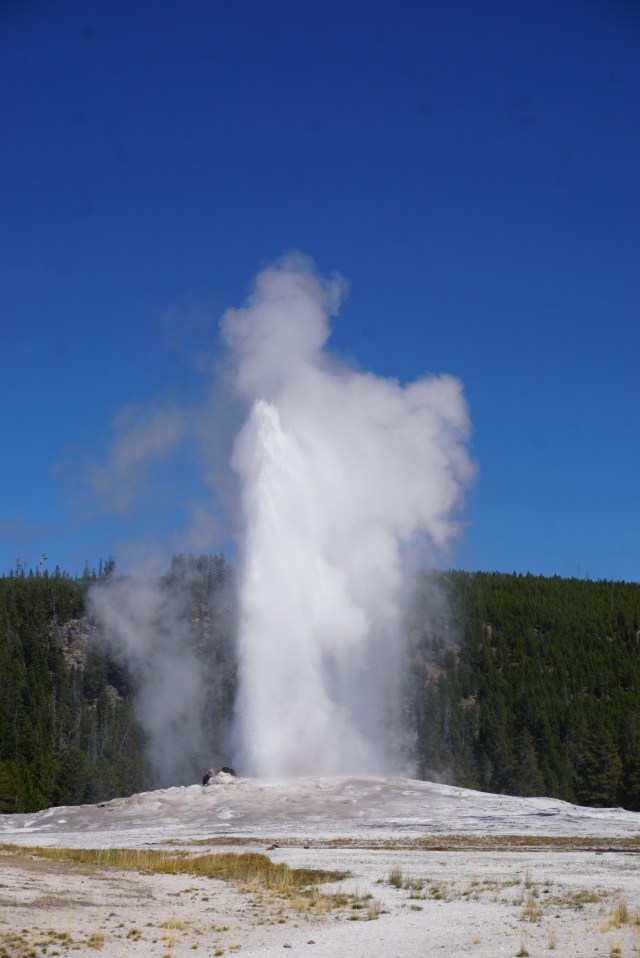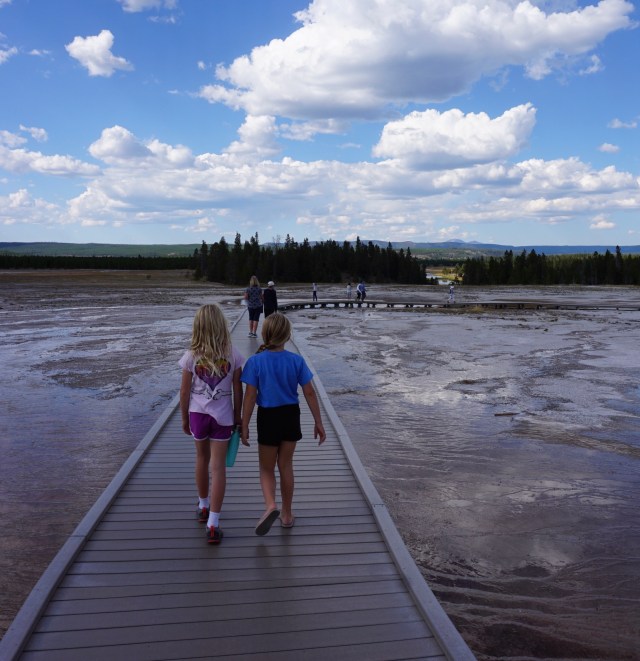Well history has been made and it’s official!!! RR, the boy who can never choose a favorite anything, has declared Yellowstone to be his favorite national park ever!
When most people think of Yellowstone they think wildlife and they think about Old Faithful, right? But it’s so funny because most people (including us!) don’t spend a second thinking about what Old Faithful actually is or why it’s faithfully erupting. After a week of learning about the supervolcano that Yellowstone sits on, RR just can’t get enough of this other-worldly place! We have learned so much.
Here’s a quick run down of what we’ve learned about Old Faithful and all the geyser basin areas which are mostly on the west side of the park.
Like I mentioned, Yellowstone represents and sits on top of one of the largest supervolcanoes on earth! Although there’s much debate about how long ago it last erupted, it did produce this massive caldera (or crater basically) that’s a huge portion of the park.
So Yellowstone is this “hotspot” where the magma under us is closer to the crust than most places, which creates all kinds of crazy geothermal features! In fact there’s over 10,000 in the park which is more than half of all the known features in the world.
There are 4 types of geothermal features: Geysers, Hot Springs, Mudpots, and Fumaroles. We’ve seen a lot of each of them.
Below are our faves of each with explanations of what each kind is:
Old Faithful of course is the most famous geyser in the world so let’s start with him!


Geysers occur when water (precipitation) that has seeped underground becomes super-heated (by that close magma I mentioned) and pressure builds and builds as heat and gas continue to make it boil. When water is heated it expands! This water with no place else to go eventually rises up through a constricted path which makes the water shoot up in a powerful eruption like its coming out of water hose.


Yellowstone has hundreds of geysers – actually it has more than 2/3rd of all the active geysers in the world. Within one mile of Old Faithful there are 140 geysers which is of course the highest concentration in the world.
(By the way – there’s a lot to see around Old Faithful with the basin, good hikes, a really great exhibit section in the visitor center, and videos… and ice cream and a grille which we enjoyed! We also had a cafeteria lunch at the Old Faithful Lodge and loved seeing the architecture there. I hear the Inn which was finished in 1903 is even better so will share that the next time we visit Old Faithful! You can easily spend half a day in this area of the park.)

Our favorite ended up being Grand Geyser which is the tallest predictable geyser in the world! I encourage you to check the NPS website for geyser predictions if you’re going to be visiting the park. Our last morning with MomMom & Pa, I saw that Grand was going to erupt and that we could make it there on time. As soon as we stepped foot on the platform, it started going off and it was awesome!



It was so powerful and big and lasted so long! It really felt like a Disney-thermal-feature and I could just picture choreographed music and dance! 🙂
There are 2 types of geysers. Cone and fountain. Old Faithful and ones like Castle, White Dome, and Sponge all seen below are cone geysers: 



They all have silicious sinter aka geyserite which is the necessary 4th ingredient to make a geyser. This rock makes up the plumbing which is necessary to make that tight constriction that won’t break down during eruptions and that holds tight to make the water shoot out.
Solitary Geyser near Old Faithful was a fountain geyser ! These geysers have water sitting above the constricted path so when it erupts, it shoots out through the water instead of a cone. Solitary Geyser was particularly awesome because it was the first time we found solitude in Yellowstone. Aaaaa.

I loved this next one! It was such a beautiful scene at Fountain Paint Pots:




Our 2nd feature to talk about is one of the Rooks’ fave new things! Hot springs! But these ones in Yellowstone are not touchable like at Sam’s in Cali and Big Bend in Texas! They’re all so tempting and gorgeous but no no no! Don’t get anywhere near even the ground near these hot springs!
To make a hot spring, it’s the same ingredients as the geyser (ample water supply, superheated magma close to the surface, and cracks and fissures in the ground) minus the constricted path. Instead of erupting, the water runs freely to the surface and forms a pool at the top. The most famous and biggest hot spring in the world is the Grand Prismatic. Make sure you see it from the overlook that you reach from the Fairy Falls Trailhead. Here she is:


Those colors you see are not minerals like you’d expect. These are actually microorganisms called thermophiles. (Theres a word origin lesson for you! Thermo- heat. Philes- attracted to.). These thermophiles are too small to see individually but together they sure are beautiful! The number of thermophiles in a 10 inch square can exceed the number of people on earth! This spring is so acidic and hot. It’s hard to believe anything can live in these conditions.
The blue color in the center (this area is probably around 200 degrees F) is the sun light reflecting back blue to us since the mineral water absorbs all other colors. It’s the natural color. (Like that lesson we learned about the rainbow spectrum in Texas!) Different microbes enjoy different temperatures. As the water gets cooler further away from center different microbes thrive. When you see yellow you’re seeing microbes that enjoy temps around 150 F. Orange are the ones that like it around 120 F. Brown = 110 F. Green = 95 F.
Isn’t that wild!?
You just have to go to the overlook to see the Grand Prismatic! Otherwise you’re just seeing this if you just do the Midway Basin area:






(Which is still pretty but just not the overlook!)
Here are a few of our other favorite hot springs from around the park.
Norris Geyser Basin:


Blue Star Spring near Old Faithful:

Firehole Lake on Firehole Lake Drive:

 Fountain Paint Pot:
Fountain Paint Pot: 
Biscuit Basin:





Emerald Spring on the back loop at Norris Basin:

We have some amazing young scientists who have done great work studying these “bacteria mats”! They earned their young scientist badge and really learned a lot! Here they are measuring temperatures around the basin:


Unlike most parks we had to pay to do the Junior Ranger and Young Scientist program but they were well worth it! AB was so cute with that bookbag haha. I’m not used to seeing that.

Some of these features we saw are right off the Grand Loop or a side road and just take a few steps from the car to get to. Others are long walks. RR is determined to see every.single hydrothermal feature listed on the maps so we are exhausted :).
This brings us to our 3rd type of feature which is the fumarole! This feature has a limited water supply so it’s mostly steam and gas that is being released. What little water is in the “system” gets flashed into steam as soon as it’s pushed out. Some fumaroles are so loud and truly sound scary.




(There are more from Norris Geyser on my first Yellowstone post!)
Finally the mudpots. These are very acidic springs with limited amount of water. They are so acidic that they turn the rock and soil around them into clay. As gases rise they bubble and pop the clay and it’s wild looking!
Mud Volcano:

Churning caldron. This one was for real scary!:


Artist paintpots:



This one was so acidic it was very close in pH to battery acid! It stunk:

I think that’s enough for now! We have much more to show you from the park. You’ll be delighted to know that RR wrote up most of this post! He wrote all the descriptions and explanations.
Do all these features look similar to you? Not to RR! He has them memorized and was able to tell me their names as soon as I pulled up their pics. What an amazing brain! 🙂
Here are 2 diagrams about the features. I could have just posted them first but that would have taken the fun out of RR’s school assignment to describe them for y’all.
This diagram was from the True North guide book:

And this one was on a sign at the park:

Isn’t this all just amazing!?! More examples of how God turns destruction and brokenness into such beauty.
Much more to come! Wait until you hear what B and I saw!!! 🙂
<Since this posted on Sept 11th it seems weird not to say anything about that horrific day. I’m so grateful for the heroes that stepped right up to confront evil head-on. I can’t believe it was 18 years ago. It still seems unreal. It still makes me cry every time I re-watch what we saw live that day. I know so many people pray for the victims’ families today and for that I’m so grateful! I pray we could have that same humble unity at the Lord’s feet every day!>


Thanks for the great science lesson.
Can you imagine exploring in early America and stumbling upon these?
Their eyes must have popped out of their heads. 😲
We can never forget 9/11 and those who paid the price to save lives. True heroes.
We kept talking about the same thing! How the early explorers must have been so scared ! I read an account one group wrote they had seen the entrance to hell!
Nice work R, I hope you got an A+ on this assignment!
We ❤️ first responders. They are real life superheroes.